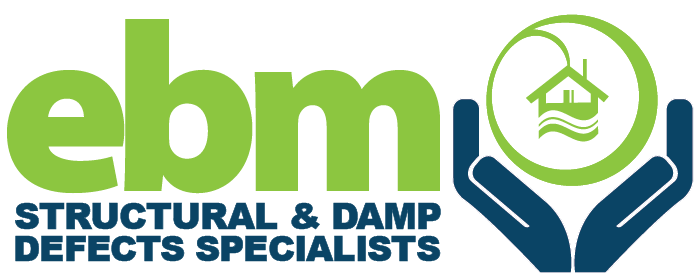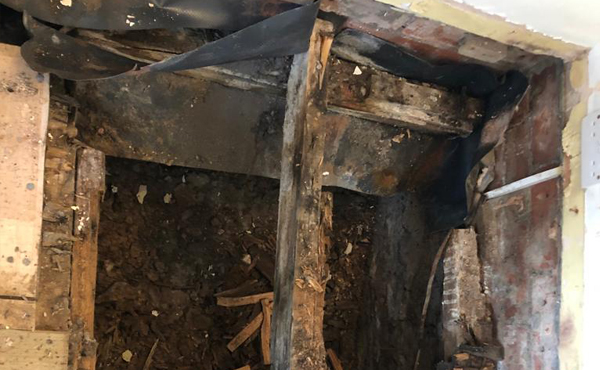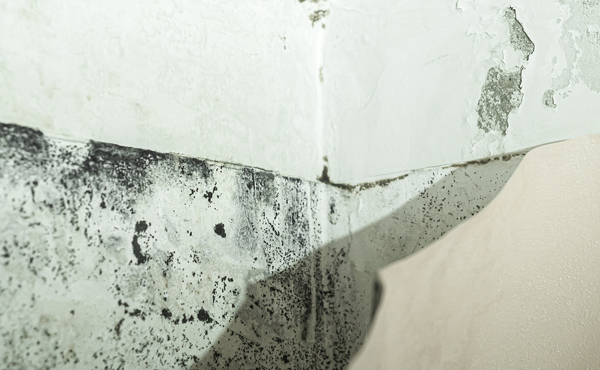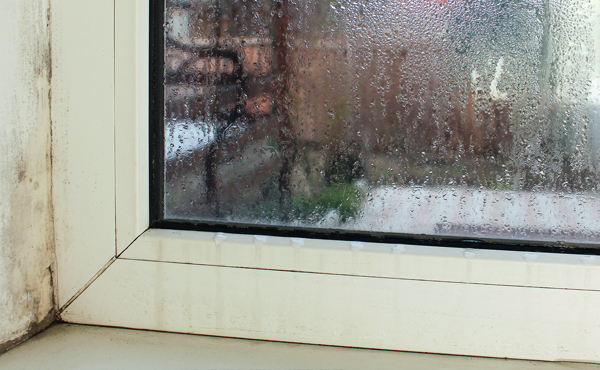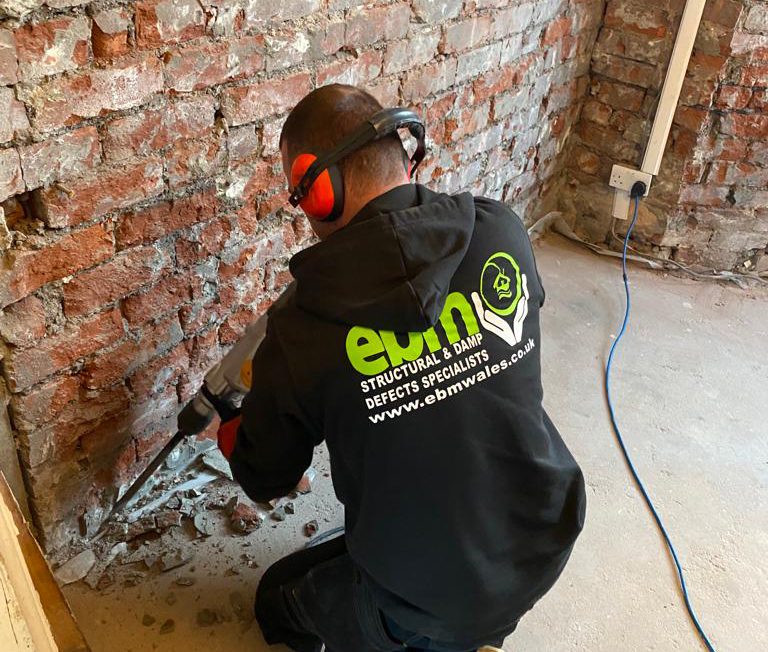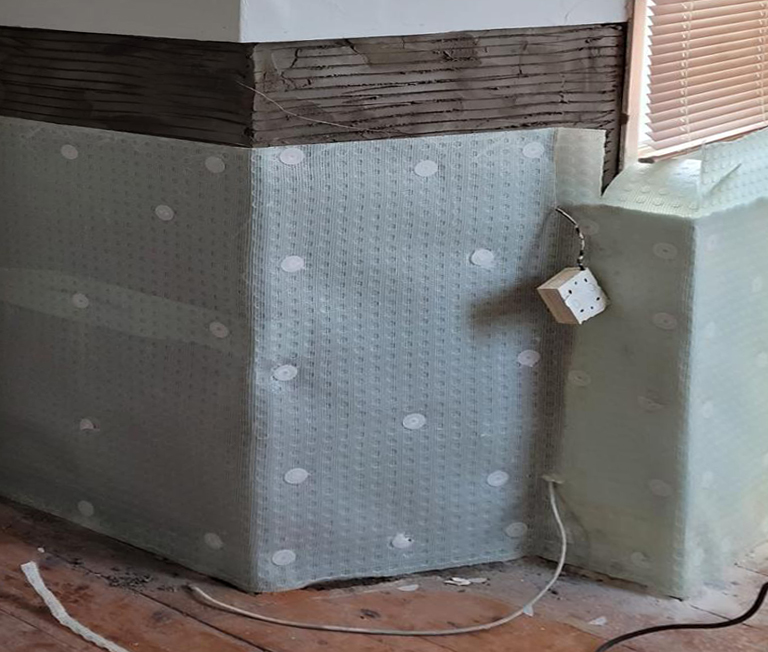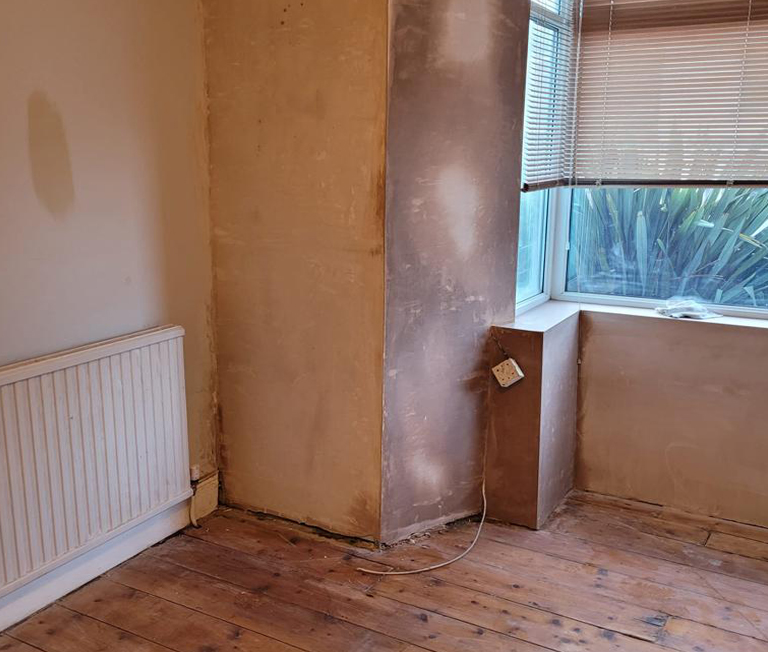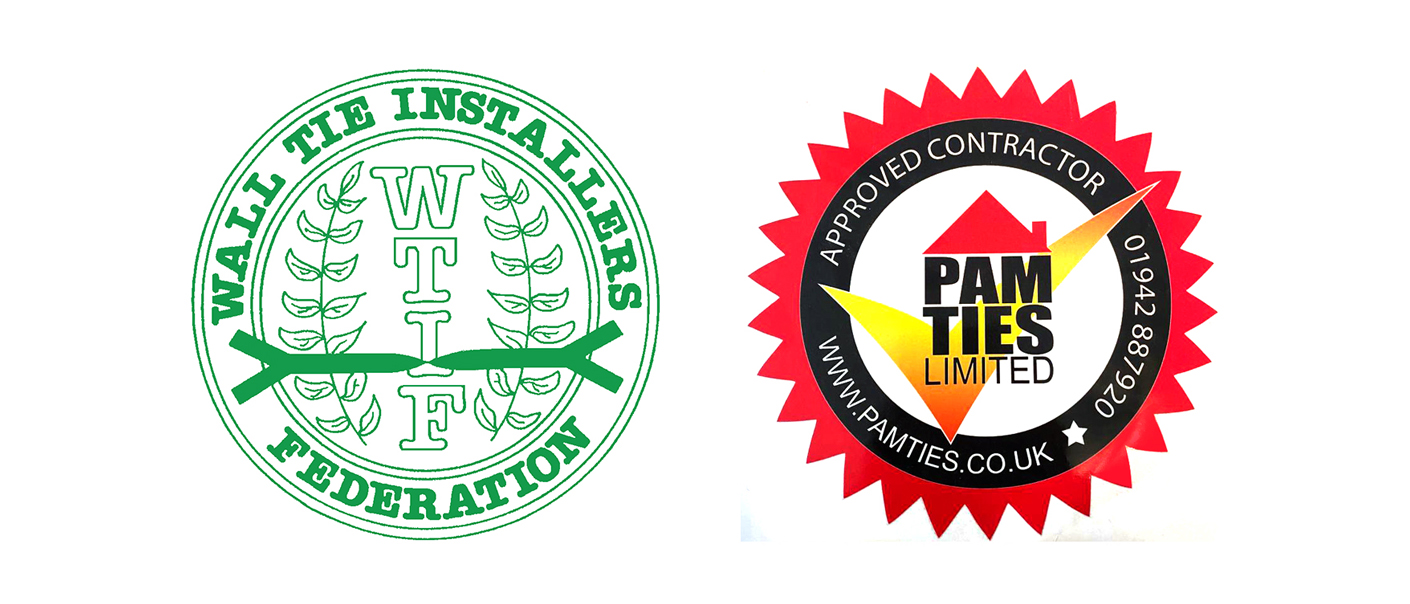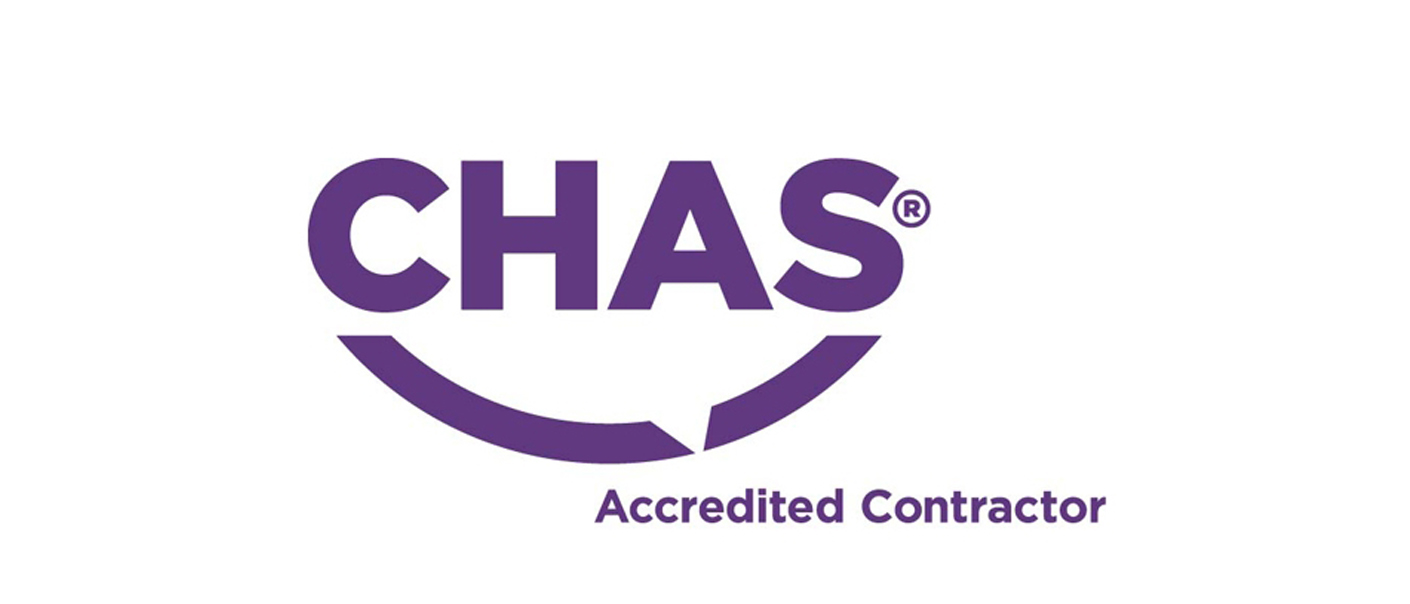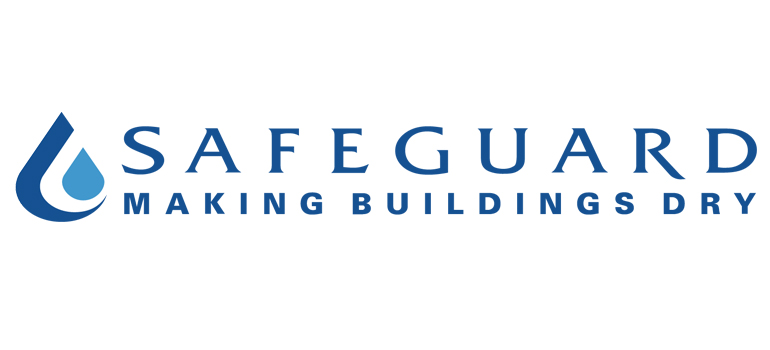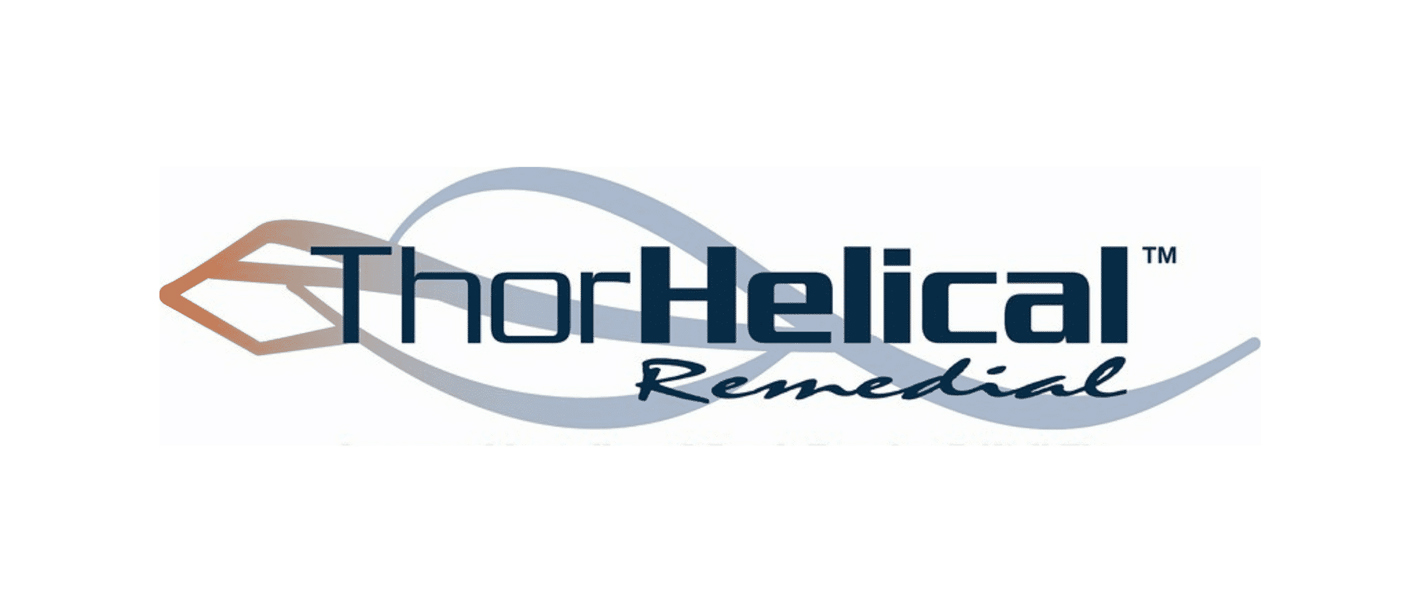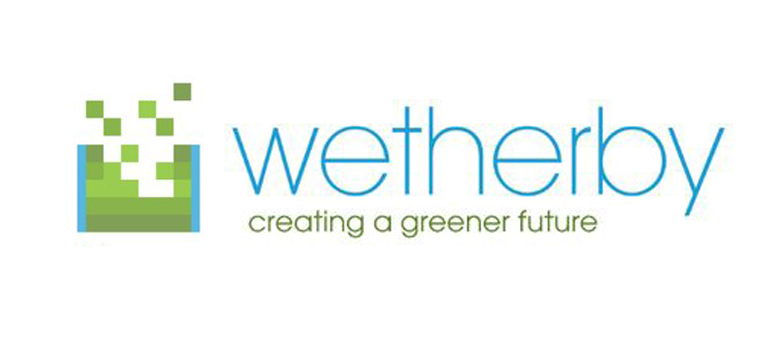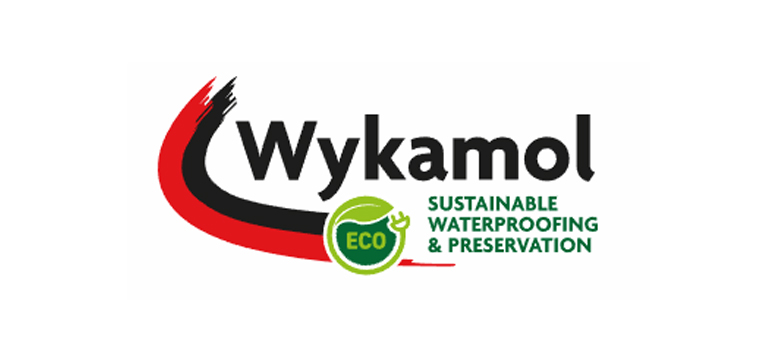Damp Proofing In Wales
Our damp proofing method works by creating a solid barrier against damp – this prevents damp setting back into the wall in the future for the treated walls. This along with our other damp proofing services ensure that damp doesn’t wreak havoc in your property again.
// We Can Help With
Damp Proofing
If you live in the around South Wales and have found damp in your property then we can help. Our experienced team has been providing damp proofing services to domestic and commercial customers for years to deal with damp problems such as rising damp, penetrating damp, condensation, dry rot and woodworm.

Can damp and mould affect my health?
Information taken from the NHS website states that if you have damp and mould in your home, you are more likely to have respiratory problems, respiratory infections, allergies, or asthma, Damp and mould can also affect the immune system. If the problem arises, contact ebm Wales today, we can help!
How does it affect your health?
Moulds produce allergens (substances that can cause an allergic reaction), irritants and, sometimes, toxic substances. Inhaling or touching mould spores may cause an allergic reaction, such as sneezing, a runny nose, red eyes and skin rash. Moulds can also cause asthma attacks.
Causes Of Damp & Mould
Mould and damp are caused by excess moisture. Moisture in buildings can be caused by leaking pipes, rising damp in basements or ground floors, or rain seeping in because of damage to the roof or around window frames. A newly built home may be damp if the water used when building it is still drying out – for example, in the plaster on the walls. Excess moisture indoors can also be caused by condensation. If you have mould or damp it’s important to find out why you have excess moisture in your home. When you know what’s causing the damp, you can make sure your home is repaired or take steps to limit the moisture in the air. You may need to get a professional to remove mould for you, but if it’s only a small amount you may be able to remove it yourself.
// Damp Problems
Rising Damp
Rising damp is a common problem that happens due to homes being built on damp soil. The moisture then rises up through the walls in the property – hence the name ‘rising damp’. As you can imagine this causes the property’s walls to absorb the moisture like a sponge causing big issues in your home.
Penetrating Damp
This type of damp usually occurs when vulnerable areas allow moisture through them. These include access through roof tiles, clogged guttering, damaged pointing, inadequate damp proofing. All of the above are ways penetrating damp can attack your property.
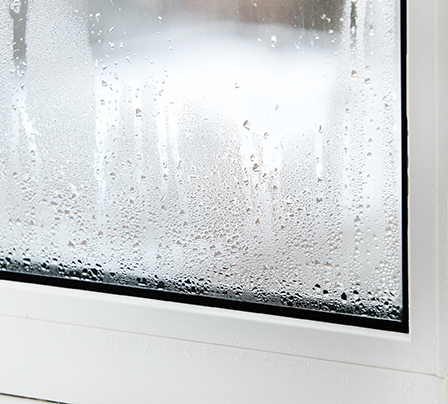
Condensation
Condensation is a very common moisture problem in homes across the country resulting in moisture gathering in certain areas as well as green and black mould forming on clothing, ceilings, walls and various surfaces.
Dry Rot
Rot is caused when moisture combined with lack of ventilation provides the ideal conditions for fungus to attack. It can affect all types of property, historic or modern and can grow within the cracks and cavities in the walls feeding off debris and wood behind the plaster.
Woodworm
Woodworm is given to the infestation of by the wooden item by the larvae of any species of beetle. Signs of woodworm usually consist of small holes in the wooden item with live infestations showing powder around the holes.
What Is A Damp Proofing Course?
A damp-proof course is one of the most important elements of a property. The DPC protects the property against moisture rising from the ground. This page will provide a deeper understanding of what is a damp proof course and what the best types of damp proof treatments are. Excess moisture gaining access to your property can result in a range of different damp issues causing damage to the fabric. It is therefore vital that you ensure that your property has an effective damp-proof course in place to repel water from the ground.
What Happens Next?
If you are worried that your property is suffering from damp or have spotted signs of damp then it is crucial that you have your property damp surveyed by a professional. To the untrained eye it can be very difficult to accurately diagnose the source of your property’s damp problem. Our team of damp specialists at ebm Wales will be able to accurately diagnose the source of the problem and provide the best solution to eliminate the damp. Ensuring that your property has an efficient damp-proof course in place is crucial to ensure your home is protected from excess moisture. Damp-proof course repair work is carried out by our specialists comes with a guarantee to give you piece of mind
CM3 Cavity Drain Mesh Membrane
is a 3 mm studded membrane incorporating a tough HDPE mesh lathing welded to the front face, allowing the direct application of various plaster finishes, adhesive ‘dabs’ and plasterboards and delivering a grade 3 environment to BS8102:2009 and NHBC Chapter 5.4.
Advantages Of Cavity Drain Mesh Membrane
• Part of a type C cavity drain membrane system in line with BS 8102:2009.
• Quick to install – minimal preparation needed to wall and floor surfaces.
• Easy to fold around windows and doors.
• Easily cut down using a sharp blade.
• No drying out process – redecoration can occur immediately.
• Little or no damage to the existing structure.
• Creates a dry, habitable living space in areas previously suffering from damp/wet conditions.
• Waterproof, salt inhibiting, root and contaminate resistant.
• Thinner diameter stud detail only 3mm.
• Now with a 1.2metre version to eliminate salt band issues.
• Easy to plaster direct onto membrane or dot and dab.
Our Process
Substrate Preparation
1. Unsound plaster, render or screed should be removed and
surfaces made level. This should be achieved using
Wykamol’s Universal Mortar, or a 3:1 sand:cement mix
incorportating Renderproof Waterproofing Additive. Leave
all new works to dry thoroughly before CM3 Mesh
membranes are fixed.
2. In case of walls suffering from mould or masonry fungi, prior
to fixing the membrane, remove surface contamination by
brushing, then apply Microtech Biocide in line with the
relevant Technical Data Sheet
3. If dry rot (Serpula Lacrymans) is present in the walls, this will
require detailed assessment before proceeding. Please
contact the Wykamol Technical Department for further
advice.
4. Above ground level it is recommended, that where possible,
all sources of moisture are alleviated at the source using a
DPC such as Ultracure, before applying CM3 Mesh
Membrane. This reduces potential damage to masonry and
timber etc.
Application
With studs facing the wall, fixing is carried out using Wykamol
CM Plaster Plugs or Brick Plugs.
1. Drill a hole through the centre of the stud. Take care when
drilling holes to avoid excessive masonry dust from falling
behind the cavity drain membrane.
2. Place the chosen plug (with seal for all underground
waterproofing applications) into the hole and drive the fixing
home with a rubber or wooden mallet.
3. We would suggest that spacing between plug fixings should
be no greater than 250 – 300 mm, to ensure a tight fix to the
wall. However, this may vary depending on chosen finishes,
dimensions of plasterboards and their exact application.
4. In above ground applications, seal the membranes by butt
jointing and oversealing with Wykamol Fibre Tape
Above Ground:
CM3 Mesh Membrane should finish at solid floor and ceiling
junctions.
Conditions & Limitations
Flat soffits below ground should never be lined with Wykamol
CM3 Mesh Membrane as it requires a minimum slope of 10%.
Take care when running CM3 Mesh Membrane around internal and
external corners to ensure the sheet is fixed tight to the angle,
ensuring well defined edges for subsequent plastering works
Finishing
Plaster Finish:
Wykamol CM3 Mesh Membrane can be finished in accordance
with standard plastering techniques (BS 5492:1990) using
proprietary lightweight plaster, such as No More Damp
Renovation Plaster.
Coat 1 should be applied to fill the studs and cover the mesh.
This is scratch finished and then allowed to set before applying
a second coat, to a final overall thickness of 15 mm. Please
make reference to our Wykamol Plaster Specification which
can be downloaded from our website.
Dry Lining:
Use a conventional bonding plaster in dabs, to a minimum
thickness of 8 mm and covering at least 50% of the membrane
surface area. After the plastered, dry-lined or rendered surface
has dried, the surface can be painted or wallpapered using the
traditional methods and materials without delay. Alternatively,
a conventional 65 mm of sand and cement screed can be laid.
Normal decorating materials can be used as soon as the floor,
screed or plaster finishes are dry.
While applying, ensure atmospheric moisture levels are below
70% RH. Impermeable floor finishes should not be laid until
screed moisture content is below 75% RH.
Aftercare
Leka Systems is known for its innovative approach to designing home improvement products, merging aesthetics and functionality.
Damp Proof Cream
The cream is delivered by hand pressure from the appropriately sized applicator gun into a series of holes drilled into the mortar course. From here, Ultracure© effectively migrates into the masonry pores and fully passivates across the mortar joint as the cream reverts to a liquid phase. Upon curing, a hydrophobic chemical damp-proof barrier is formed in-situ. Extensive field experience with this technology demonstrates that Ultracure© will perform as well as any conventional liquid injection system against rising damp.
Ultracure© cream is designed to control rising damp, but walls can remain damp after a DPC installation where they are severly contaminated with hydroscopic salts. Replastering with an appropriate, salt resistant product, such as Renovation Plaster or Renderproof, is essential to prevent further damage to the plaster finish. In all cases the damp-proof course should, as far as possible, be installed in accordance with British Standard ‘Code of Practice for Installation of Chemical Damp Proof Courses’ BS6576:2005.
Advantages
• Effective for at least 20 years
• BBA approved
• No high pressure injection pump needed
• No pump cleaning between jobs
• Can be used in conjunction with dampstop mesh membrane kit
• Finish with renderproof or renovation plaster
• Easy, fast and clean installation
• Virtually odourless
• Can be used in all types of masonry
• Precise dosing and Low hazard
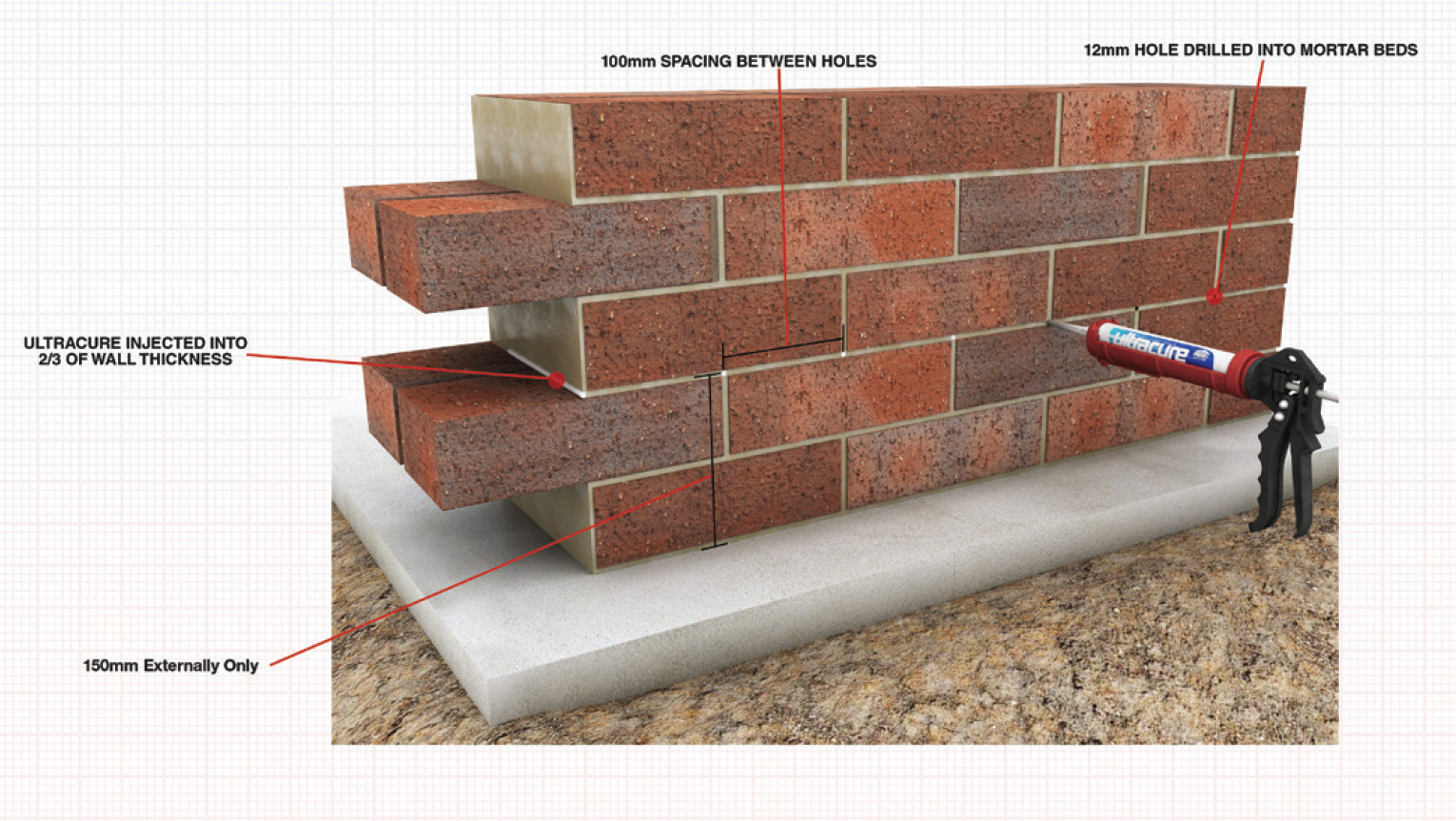
Our Process
Substrate Preparation
1. Check and overhaul rainwater goods to ensure they are clean
and in good working order. Repair or install drains to carry
away surface water.
2. If internal floors are below external ground level, form trenches
along the external face of the walls to at least 150 mm below
the proposed DPC level (where foundation depth allows). If
this approach is not feasible the DPC must be placed at 150
mm above external ground level and the internal walls tanked
below the DPC to prevent lateral migration of moisture/salts
(see Wykamol Re-Plastering Specifications and/or contact the
Wykamol Technical Department).
3. Remove skirtings, fixings and render/plaster to expose the line
of the proposed DPC (mortar bed). Internal plaster affected by
hydroscopic salts is removed from the area to be treated to a
height of 300 mm above the maximum level of the rising
damp.
4. Check flooring timbers for signs of fungal decay and
recommend repair/ replacement as appropriate.
5. Ensure wall cavities are cleared of debris.
Vertical DPCs should be provided to connect horizontal DPCs
where ground levels change and to isolate untreated wall areas
(adjoining properties, garden walls etc.) In most cases solid brick
walls may be drilled and injected from one side only.
For cavity walls each leaf may be dealt with as a separate 115 mm
thick wall (see coverage rates below). Alternatively, if preferred,
drill through the selected mortar course, across the cavity, then
drill the outer leaf of brickwork to a depth of 100 mm and inject
in one continuous process (the physical properties of Ultracure©
ensure the cream remains in contact with the surrounding mortar
even when the mortar bed is drilled through in this way). Always
ensure that the cavity is clear before treatment.
In random stone and rubble infill walls, as far as practically
possible, follow the mortar course at the appropriate level.
However, if the stone is of a porous type, it may be possible to
vary the drilling locations (mortar/stone) as long as the mortar
bed perpends are treated. In walls of a thickness greater than 350
mm, it is recommended that drilling is undertaken from both
sides at a corresponding height. In the case of drill holes
becoming blocked these should be re-drilled just prior to
injection or a new hole should be drilled nearby to ensure that an
adequate volume of Ultracure© is introduced.
Drilling Preperation
Walls vary in thickness and type of construction so it is essential
these factors are taken into account before deciding on an
appropriate drilling pattern. DPC height should always be at least
150 mm above external ground level. In the case of solid floors,
insert the DPC as close to floor level as possible.
DRILL HOLE SIZE, DEPTH AND LOCATION: Drill 12 mm
diameter holes horizontally in the mortar bed at distances no
greater than 120 mm. The depth of the hole required for various
sizes of wall is shown in the table below (approx. 90% of any
given wall thickness). For walls of intermediate thickness the
depth of holes should be pro rata. Where the masonry is
irregular, ensure the horizontal drilling pattern targets the base of
all perpends of the course selected. Drill hole depth required,
dependent on wall thickness:
Application
ULTRACURE INJECTION: Insert Ultracure cartridge into
appropriate gun applicator. Insert the applicator nozzle into the
full depth of the predrilled hole. Squeeze the gun and trigger and
back fill each hole fully with Ultracure© cream to within one
centimetre of the surface. When treating cavity walls from one
side make certain that the holes in each leaf are filled.
Application Limitations
Spilt material should be wiped up immediately and the wipes
disposed of appropriately. Contaminated surfaces should be
washed immediately with warm soapy water. If Ultracure© cream
penetrates non-target surfaces (e.g. a patio slab) it will normally
dry clear to finish. However, if staining arises consult the
Wykamol Technical Department for further advice.
Finishing
On external faces of walls, drill holes can be re-pointed using a
matched mortar or can be plugged with Wykamol Injection plugs
in stone, rustic or brown. On internal faces holes can be left open
and plaster stopped short of the DPC.
Thin Internal Wall Insulation & Damp Control ( TIWI )
A new and innovative patented textile based thermal system
for wall insulation & damp control, for dry and warm walls.
ISO-THERM is an ultra thin (+/-4mm) specially woven polyester
based material, which is both unique and patented. Available in rolls of 1 metre wide, it is flexible and lightweight and will accommodate a multitude of wall finishes. Due to its ease of use and flexibility it can be cut around light switches/sockets/radiator brackets and the like, and is minimally invasive in its installation. Very often , door architraves and skirtings can remain in place, and because of its malleability it fits around and into window reveals with ease.
Designed To Save Energy & Keep Walls Dry
It is fixed in place with our unique ISO-THERM adhesive, normally trowelled onto the wall to a thickness of circa 5mm, and with the ISO-THERM affixed and rolled into the adhesive, the overall finished depth after a direct plaster skim coat is approximately 10mm. ISO-THERM is vapour permeable, but waterproof, thereby resisting any lateral damp transference, and stopping the subsequent natural surface nitrates and chlorides forming as an efflorescent salt. Because if its high thermal benefit, and the withholding of any natural damp transference it is highly resistant to any formation of surface mould.
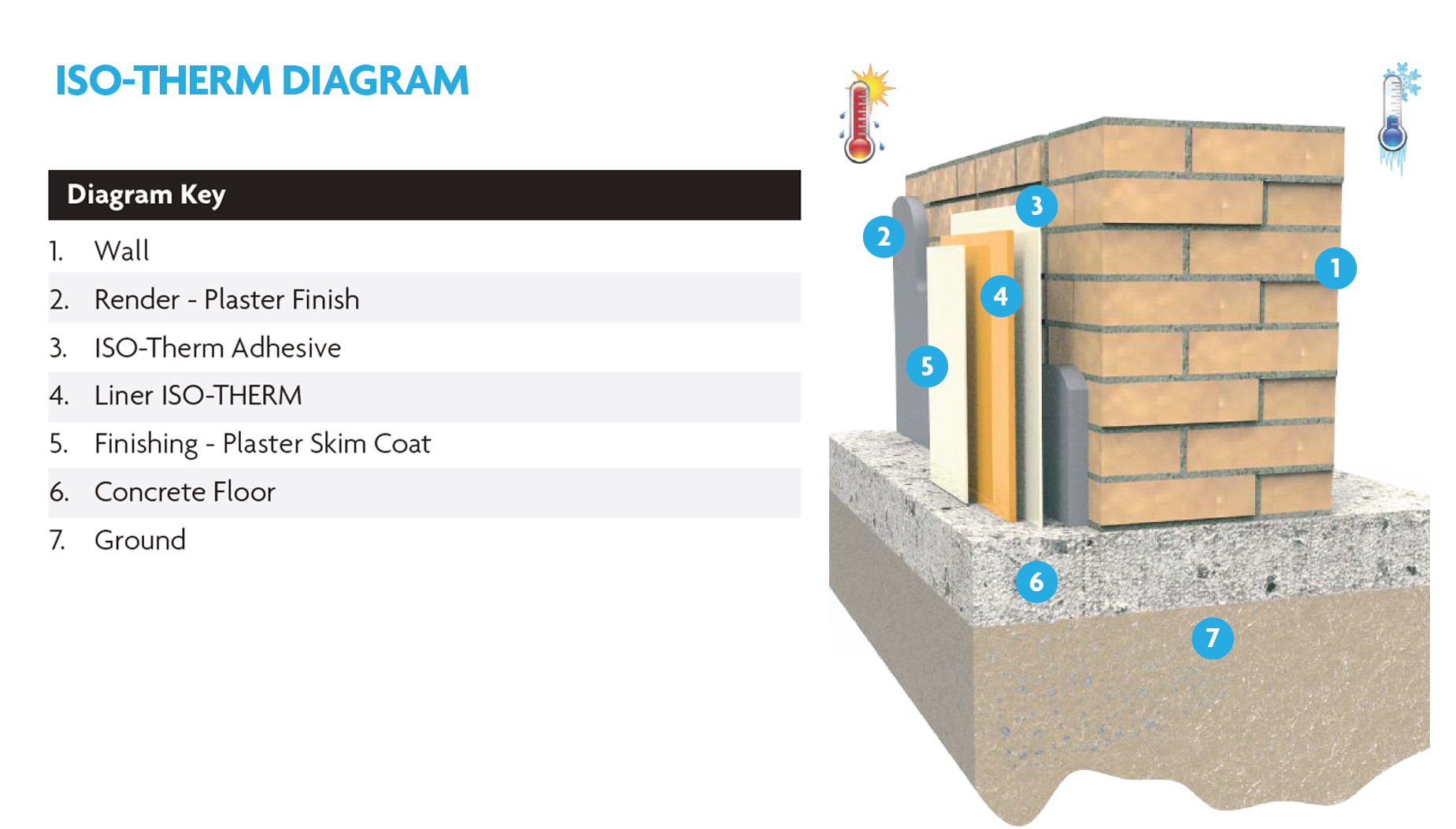
Iso-therm Description
ISOTHERM is a thermal insulator made from 100% polyester
non-woven fabric coated with a flame-retardant acrylic
compound, 100% water-based.
Iso-therm Adhesive
A mineral adhesive, ready for use. Composed of stabilised
potassium silicate, siliceous aggregates, quartz sand with
specific granulometry and other additives. It is permeable and
water repellent.
Water Stop – Plugging And Repair Mortar
WaterStop is formulated for the rapid patching and plugging of active water leaks and seepage in concrete and masonry. WaterStop is designed to expand as it sets to ensure a permanent water tight seal is achieved and displays similar properties to concrete when cured. Used to stop active water leaks or seepage under pressure through holes, joints and cracks in concrete or masonry walls, swimming pools, tunnels, fountains, cisterns, water channels, ponds, pipes, basements, foundations and retaining walls.
Water Stop Process
Substrate Preparation
Remove by suitable means, all loose pointing, any remaining
render or plaster, wood, dust, grease, oil, organic growth or other
foreign materials that may cause contamination or adversely
affect adhesion.
Clean the hole, crack or joint thoroughly by wire brushing,
chiselling or scraping loose materials until a clean, sound substrate
remains.
Areas to be patched should be cut back and given a good
mechanical key. Feather edges are not suitable.
To seal leaks and cracks, openings must be chased out to
approximately 20 x 20 mm. The edges must be square or under
cut, avoiding V-shaped cuts. All loose material generated while
chasing out should be removed.
Mixing
Due to the fast setting nature of HydraDry WaterStop, it is very
important to organise the work space before mixing commences.
Ensure the person undertaking the repair is situated close to the
repair area and the equipment required to carry out the repair is
easily accessible.
Recommended Water Additions
Size Pliable Mortar
1 Kg 250 – 270 ml
100 g 25 – 27 ml
When mixing HydraDry WaterStop, use ONLY CLEAN WATER and a
clean mixing vessel. For the best results the temperature of the mixing
water should be between 5°C and 10°C. The warmer the water is the
faster the mortar will begin to set.
Note: Mix only enough material for immediate use. WaterStop sets in
60 – 90 seconds and cannot be reworked once it has set.
Wearing chemical resistant gloves, mixing is ideally done by hand.
1. Measure out required water and powder into SEPARATE
containers.
2. Add the powder to the water and mix quickly and thoroughly.
3. Roll the mixture between your hands until a pliable, putty like
consistency is developed.
4. Once the materials start to warm-up, immediately apply the
product to the prepared area.
5. Hold in place until water leakage/seepage stops and the
product has cured (approximately 30 seconds).
Application
ULTRACURE INJECTION: Insert Ultracure cartridge into
No priming is required, but for dry repair applications make sure
the surface is Surface Saturated Dry (SSD).
To stop surface leaks or seepage not under pressure:
1. Starting at the top of the hole or crack, work your way down.
Trowel apply or hand press the mixed mortar firmly into place,
ensuring maximum contact with the substrate before the
material sets.
2. Remove any excess material to form a uniform surface.
To stop leaks under pressure or under water:
1. Starting at the top of the hole or crack, work your way down.
Trowel apply or hand press the mixed mortar firmly into place,
ensuring maximum contact with the substrate before the
material sets.
2. Maintain constant pressure on the applied material until final
set has been achieved.
3. Remove any excess material to form a uniform surface.
Conditions & Limitations
It is not advised to use warm water for mixing. The information
in this data sheet is based on the addition of water at 5-10°C and
ambient temperatures of 20°C.
The product should not be applied in temperatures under 5˚C
and falling, or if temperatures are expected to fall below 5˚C
within 24 hours. Ensure the substrate temperature is not below
5˚C before commencing application. Setting times will vary
based on ambient temperatures and water temperature, with
higher temperatures reducing setting times and lower
temperatures extending them.
Plugging Compound
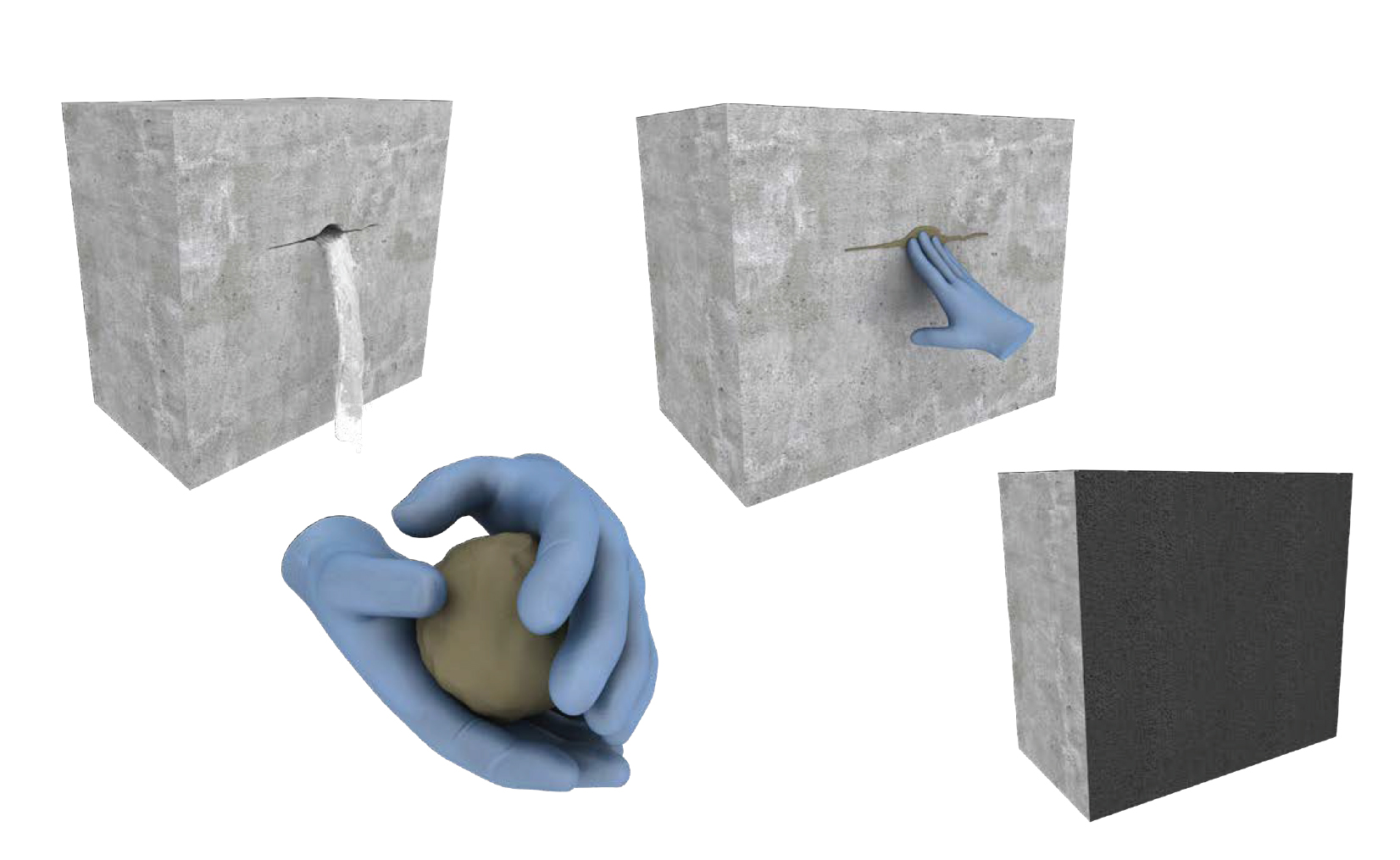
Curing
Final setting time is less than 2 minutes. Once the product has stiffened sufficiently, dampen with clean water and maintain a damp condition for approximately 15 minutes.
Advantages
• Permanent waterproofing for concrete and masonry.
• Resists positive and negative water pressure.
• Superior bond strength.
• Resists salt contamination in masonry.
• Suitable for use above and below ground level.
• Suitable for internal and external use.
• Safe to use in contact with potable water (WRAS approved).
• Easy to use, brush, roller or spray applied.
• Ideal radon barrier
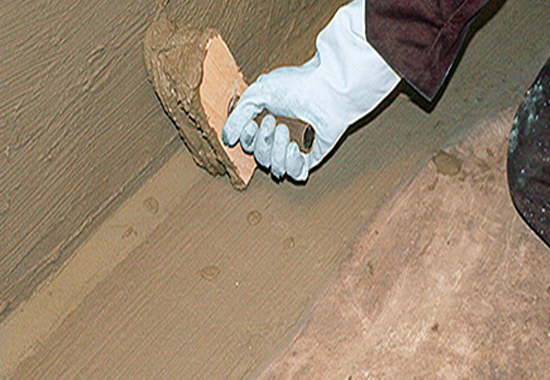
Tanking Slurry Process
Substrate Preparation
All active water leaks must be stopped using Waterstop (rapid setting
plugging compound) before continuing to the next stage of application.
Uneven surfaces:
Remove by suitable means, all loose pointing, any remaining render or
plaster, wood, dust, grease, oil, organic growth or other foreign
materials that may cause contamination or adversely affect adhesion
properties. To create a level surface, Universal Mortar should be applied
in line with the relevant data sheet, which is available upon request or
can be downloaded from our website. Follow the Universal Mortar
priming requirements before application.
Level Surfaces:
If there is any exposed steel present, apply two coats of suitable
corrosion inhibitor to the exposed steel, by brush. Remove all loose
material and surface latencies, i.e. dust, oil, grease, corrosion and organic
growth, preferably by using wet grit or water blasting techniques. The
strength of the concrete subbase must be a minimum of 25 N/mm².
Note: Special precautions may be necessary to ensure a continuous
waterproof barrier at the wall to floor joints and corner joints. This is to
avoid sharp changes of angle in the tanking membrane. The joints
should be thoroughly raked out and cleaned prior to an application of
Universal Mortar as a fillet seal.
Construction Joints
For all construction joints including, angled, movement, expansion or
connection joints, please refer to the Wykamol Proflex Tape data
sheets.
Priming:
• Using a brush, roller or spray, apply SBR Latex, mixed 1:1 (by volume)
with water.
• Allow to become tacky to the touch. This will take approximately 30
minutes to 2 hours.
Mixing
HydraDry Tanking Slurry’s consistency can be varied to suit the
application method.
Required Water Additions
Pack Size Brush Applied Trowel Applied Spray Applied
20Kg 3.2 – 4 Litre 3.2 – 3.6 Litre 3.5 – 4.2 Litre
When mixing HydraDry Tanking Slurry, use ONLY CLEAN WATER, a
clean mixing vessel and a mechanical mixer.
1. Pour min required addition of clean water in to the mixing vessel.
2. Using an electric paddle, gradually start to add the powder whilst
mixing under low shear to reduce dust generation.
3. Add all powder and increase mixing shear.
4. Mix for approx. 1 – 3 mins to achieve a uniform, lump free slurry.
5. If necessary, gradually add water and mix until desired consistency
is achieved. Do not exceed maximum required water additions as
this will result in the product becoming inaffective as a waterproof
barrier.
Note: Excessive mechanical mixing should be avoided. Mechanical
mixing time must not exceed 5 minutes.
Application
HydraDry Tanking Slurry is a minimum 2 coat application, with each
layer applied at a uniform thickness of at least 1 – 1.5 mm per coat,
totalling 2 – 3 mm final cured thickness.
For use as a radon barrier, apply coats at a minimum thickness of
2.5 – 3 mm, totalling 5 – 6 mm minimum final cured thickness.
Brush and trowel applied:
Apply in even layers using a stiff bristled brush or broom/trowel on
vertical surfaces and a rubber squeegee or stiff bristled brush /trowel
for horizontal surfaces. It is essential the first coat is well brushed or
trowelled into the surface to ensure a good bond with the substrate.
Allow the first coat to harden (approx. 2-5 hours).
Apply a second coat of HydraDry Tanking Slurry as soon as the first
coat has hardened, but not fully set. Apply the second coat at 90°
angle to the first, ensuring a minimum overall thickness of 2mm.
Spray applied:
Use traditional wet mortar spraying equipment and processes, ensuring
final coat provides a uniform thickness of at least 2mm.
The product should not be applied in temperatures under 5°C and
falling, or if temperatures are expected to fall below 5°C within 24
hours.
Ensure the substrate temperature is not below 5°C before
commencing application. Avoid application in direct sunlight to
prevent rapid drying out. If HydraDry Tanking Slurry dries out too
rapidly between coats, repeat priming process.
When applying to environments that will contain aquatic life, such as
ponds, always finish with Wykamol Technoseal DPM, and refer to the
relevant data sheet, which is available upon request or can be
downloaded from our website, for application instructions.
Note: Gypsum plaster must not be used in direct contact with
HydraDry Tanking Slurry.
CALL
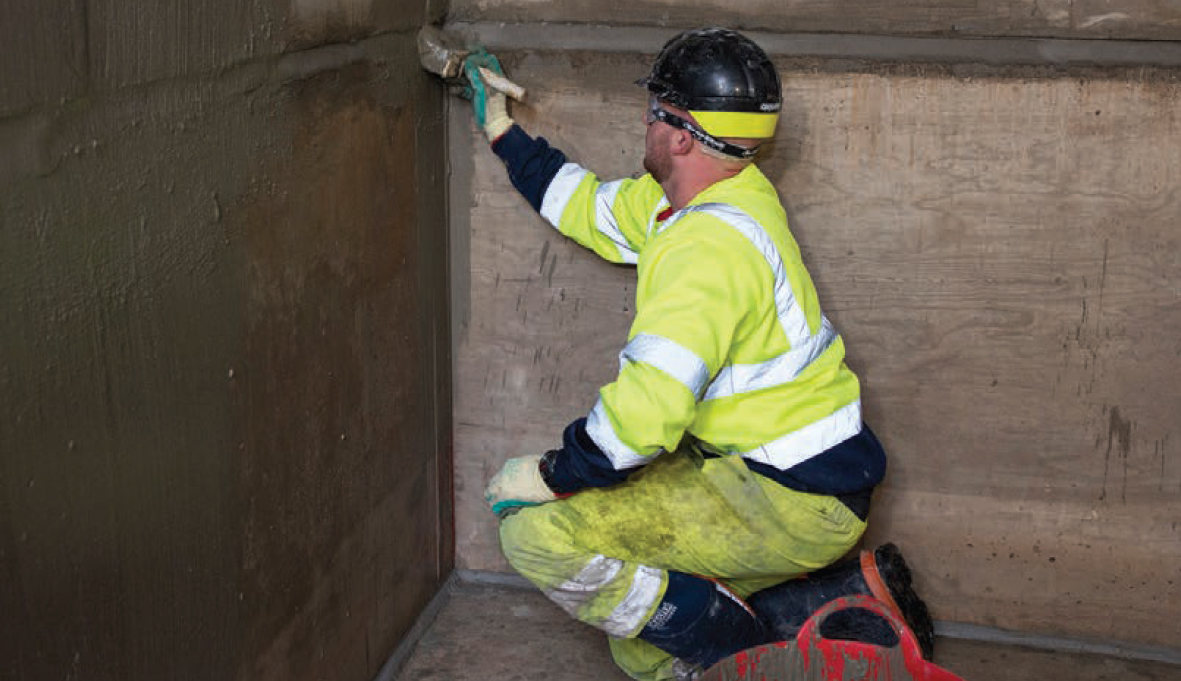
Overcoating & Finishing
HydraDry Tanking Slurry is suitable for overcoating once correctly and thoroughly cured. Plaster should take place using Wykamol’s Renovation Plaster, ideally 48 hours after the final coat of HydraDry has been applied.
Repeat priming process as detailed in the substrate preparation section, prior to an application of Renovation Plaster. If HydraDry Tanking Slurry has been applied as a DPC, breathable paint must be used on top of any finish. If redecoration is to occur 12 months after the DPC installation, non-breathable finishes may be considered.However, the moisture content of the plaster and background must be in line with the recommendations of the supplier of the chosen finish
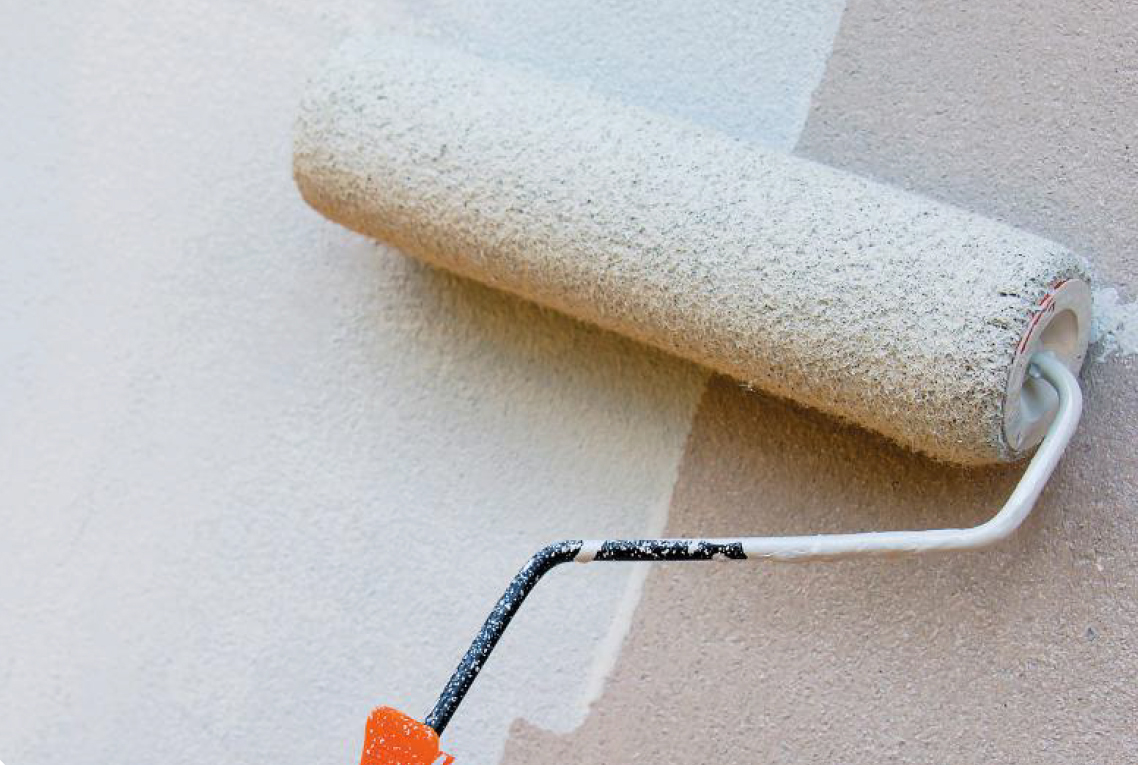
Thermal Dry – Anti Condensation Paint
Thermaldry Anti-Condensation Coating is both thermally insulating and water repelling. It increases the wall temperature, thus reducing the ‘dew point’, or the temperature at which condensation occurs. ThermalDry incorporates Micro-technology in the form of hollow glass beads, with a size of 50um and a crush strength of 500 psi. The micro, hollow glas beads act like a miniature ‘Thermos Flask’, reflecting thermal energy away from the walls, preventing the water from condensing.
Advatages
• Coating is waterproof when dry and walls are warm to the touch.
• Takes up to 60% longer for condensation to occur on walls.
• Can be painted or wall papered over with any finish, without reducing its effectiveness.
• Suitable for any interior wall – particularly exterior facing walls, bathrooms & kitchens.
• Prevents formation of black mould and other harmful fungi.
• Eco-friendly and antibacterial.
• Reduces the risk of condensation.
• Increases the life of your chosen paint or wallpaper finish.
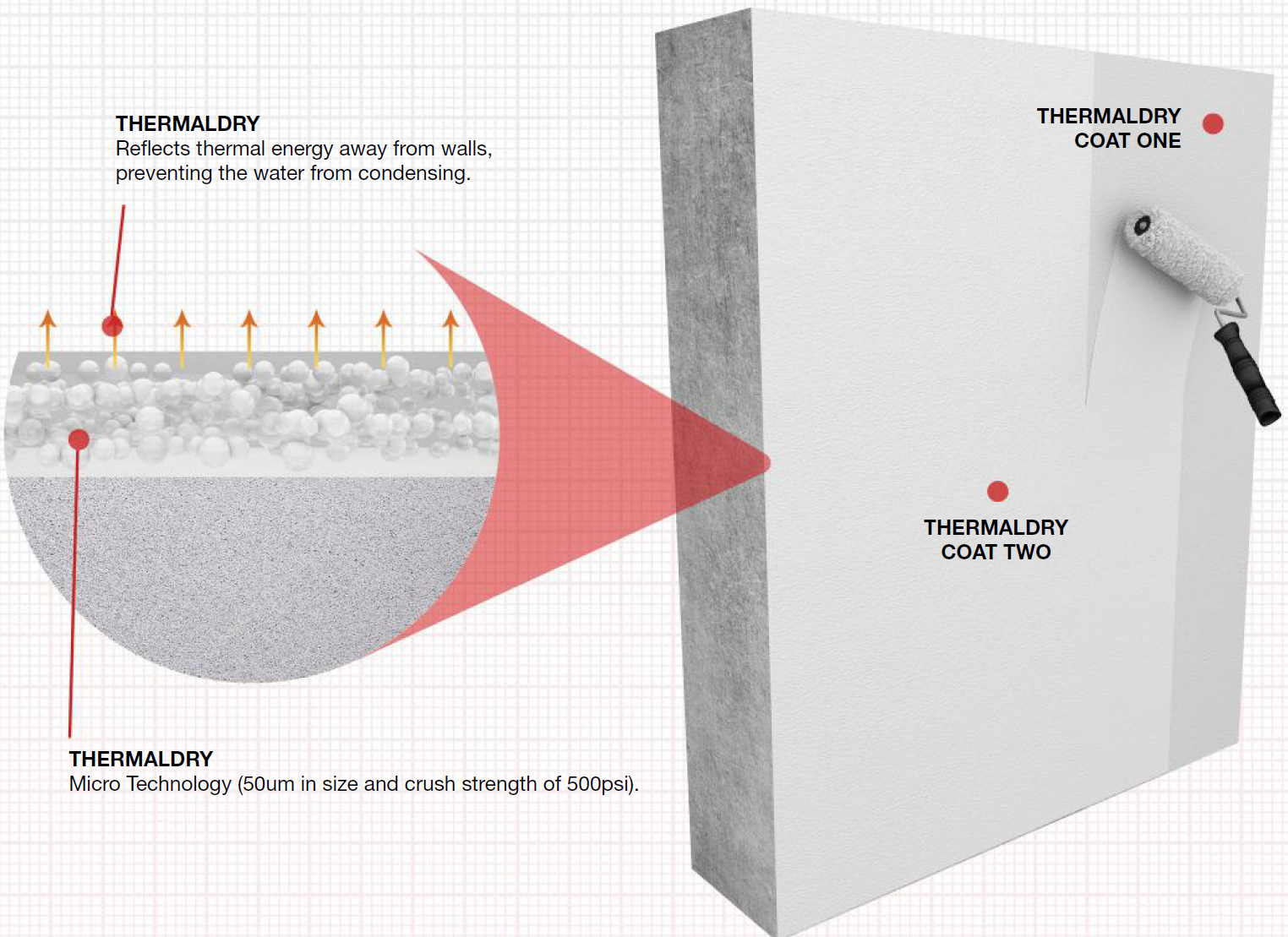
Thermal Dry Process
Substrate Preparation
Ensure surface is free from mould and fungus using MCS1 Mould
Clear Solution. Remove any loose paint, wallpaper, grease, oil
stains or any other finishes. Any cracks must be filled using a
crack filler and left to set before application can commence.
For plastic, metal or other surfaces that are not masonry, please
refer to the plastic or metal manufacturers data sheets for their
advice on the correct primers to use on their products.
Prior to applying the Wykamol ThermalDry water-based
product, or speak to our technical department for further
information if unsure on which surfaces the ThermalDry product
can be used on. An inspection should also be made to check for
any previous coatings or finishes, as the ThermalDry needs to
key to a surface or substrate.
Mixing
Upon opening the tin, gently stir the medium in order to
ensure glass bubbles are evenly spread throughout.
DO NOT USE mechanical stirrer as this could damage the glass
beads
Application
ThermalDry is designed for easy application with either a brush
or roller. Allow 2-4 hours between application of coats. 2 coat
application is necessary. Do not apply ThermalDry below 5°C or
above 30°C
Curing
Allow for 2-4 hours between application of second coat of
ThermalDry and before applying chosen finish.
Let’s Talk
Contact the Team at ebm
Contact us here for some friendly advice on how we can help you and your property

Fast and efficient service

Professional Workmanship

Industry Experts

Over 30 Years Experience

I had EBM carry out a lintel replacement and damp proofing. They were brilliant from start to finish. They were clear in their quotation, kept me informed on a start date, turned up on time and got the job done on schedule and took every care in keeping my house clean. I'd highly recommend EBM
Kevin Burke
I had EBM carry out a lintel replacement and damp proofing. They were brilliant from start to finish. They were clear in their quotation, kept me informed on a start date, turned up on time and got the job done on schedule and took every care in keeping my house clean. I'd highly recommend EBM
kevin_burke_98
Work is near completion. Chris and the guys have been brilliant - very considerate and hard-working. The job has taken a while due to the consistent rain we have had the last couple of months but Chris has kept in constant communication to update me on when work can continue. Highly recommend.
christine44085
Couldn't be happier with the work the team have done. So professional, friendly and have been amazingly flexible throughout the whole process despite a pandemic. Open, honest and always cleaned up. Would recommend anytime and will certainly be calling Chris again for future work
mrs23060
Send us a quick message today!
We’re always happy to help and advise, or offer some friendly advice

